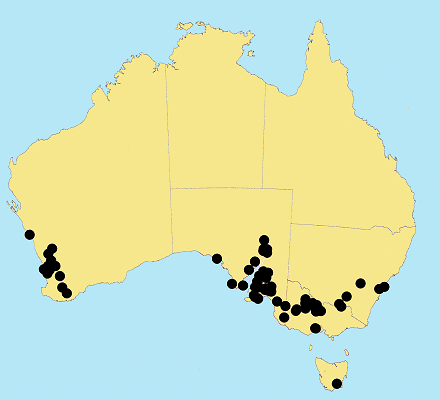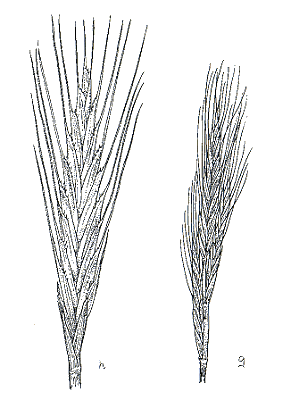Brachypodium distachyon* (L.) Beauv. Ess. Agrostogr. 101, 155, 156 (1812).
Classification. (GPWG 2001) : Subfamily Pooideae. Tribe Brachypodieae.
Basionym and/or
Replacement Name: Bromus
distachyos L., Fl. Palaest. 13 (1756).
Type of Basionym or
Protologue Information: LT: (LINN-93.48). LT designated (as NT) by
Schippmann & Jarvis, Taxon 37: 158, f. 1 (1988). Jarvis now believes
this to be original material, so that a lectotype designation is correct (fide:
Jarvis, The Linnaean Plant Name Typification Project).
Key references (books
and floras): [1952] C.A.Gardner, Flora of Western Australia 1 Gramineae
(86), [2002] D.Sharp & B.K.Simon, AusGrass, Grasses of Australia,
[2006] J.Jessop, G.R.M.Dashorst, F.M.James, Grasses of South Australia
(261), [2008] S.W.L.Jacobs, R.D.B.Walley & D.J.B.Wheeler, Grasses of New
South Wales (171), [2009] A.Wilson (ed.). Flora of Australia, Vol
44A. Poaceae 2 (79).
Illustrations:
[1952] C.A.Gardner, Flora of Western Australia 1 Gramineae (87,
Pl. 24), [2006] J.Jessop, G.R.M.Dashorst, F.M.James, Grasses of South
Australia (262, Fig. 203 & plate
8), [2008] S.W.L.Jacobs, R.D.B.Whalley & D.J.B.Wheeler, Grasses of New
South Wales, 4th edn (171), [2009]. A.Wilson (ed.), Flora of Australia 44A:
Poaceae 2 (84, Fig. 12).
Habit. Annual.
Culms erect or geniculately ascending or decumbent, 3–37(–50) cm tall. Lateral
branches branched. Leaves cauline. Leaf-sheaths hairy. Ligule an eciliate
membrane, 0.4–2 mm long, abaxially hairy. Leaf-blades 1–13 cm long, 0.9–6 mm
wide. Leaf-blade surface indumented.
Inflorescence. Inflorescence
solid, a raceme (spike-like). Racemes 1, 2–8(–10) cm long, bearing 1–7 fertile
spikelets on each.
Spikelets.
Spikelets sessile or pedicelled. Fertile spikelets many flowered, with at least
2 fertile florets (5–16), comprising 5–16 fertile floret(s), with diminished
florets at the apex, oblong, laterally compressed, 10–30 mm long.
Glumes. Glumes
dissimilar. Lower glume lanceolate, coriaceous, without keels, 5(–7) -nerved.
Lower glume apex muticous. Upper glume oblong, 6–8.5 mm long, coriaceous,
without keels, 7–11 -nerved. Upper glume apex muticous.
Florets.
Fertile lemma 8–10.2 mm long, without keel, 7 -nerved. Lemma surface glabrous
or indumented. Lemma apex awned, 1 -awned. Median (principal) awn (1–)4.5–15 mm
long overall. Lodicules present. Anthers 3.
Continental
Distribution: Europe, Africa, Temperate Asia, Tropical Asia, Australasia,
North America, and South America.
Australian
Distribution: Western Australia, South Australia, New South Wales,
Victoria, Tasmania.
Western Australia:
Irwin, Dale, Menzies, Avon. South Australia: Flinders Ranges, Eyre
Peninsula, Northern Lofty, Murray, Yorke Peninsula, Southern Lofty, Kangaroo
Island, South-eastern. New South Wales: Central Coast, South-Western
Slopes. Victoria: Grampians, Lowan Mallee, Riverina, Volcanic Plain. Tasmania:
East Coast.
Notes. Native
to the Mediterranean, now widely introduced and naturalised in temperate
regions world-wide. Uncommon; usually on sandy, rocky soils, in dry disturbed
areas. Flowers Sept.-Dec.



